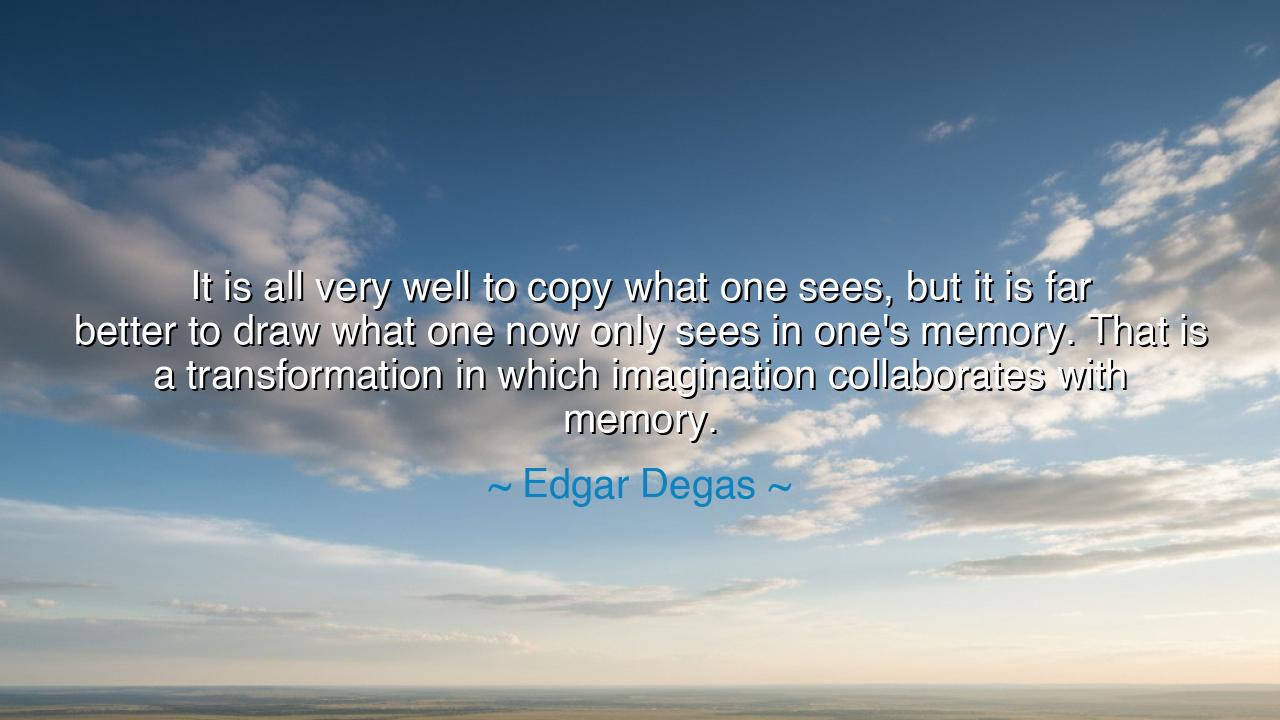
It is all very well to copy what one sees, but it is far better
It is all very well to copy what one sees, but it is far better to draw what one now only sees in one's memory. That is a transformation in which imagination collaborates with memory.






“It is all very well to copy what one sees, but it is far better to draw what one now only sees in one’s memory. That is a transformation in which imagination collaborates with memory.” Thus spoke Edgar Degas, the master of movement and grace, whose paintings captured not the cold precision of sight, but the living spirit of experience. In these words, Degas lifts the veil between perception and creation, teaching that true art — and indeed, true understanding — is born not from imitation, but from transformation. The artist’s task, he says, is not merely to mirror the world, but to reimagine it, to breathe into it the essence of the soul.
To “copy what one sees” is to be faithful to the outer form; it is the work of the eye. But to “draw what one now only sees in one’s memory” is to be faithful to truth as the heart knows it — truth distilled by time, shaped by feeling, and refined by imagination. For when sight fades and only memory remains, the mind ceases to see mere details and instead perceives meaning. The shadows deepen, the light becomes symbolic, the gesture eternal. It is in this space — where memory and imagination intertwine — that art transcends the visible and enters the realm of the immortal.
Degas, though a painter of the physical, was a philosopher of the unseen. His dancers, his bathers, his figures in motion were not frozen imitations of the eye’s momentary vision; they were recollections — impressions remembered and reimagined. He would sketch tirelessly, not to reproduce what stood before him, but to learn its rhythm, to absorb its spirit, and later, to call it forth from the sanctuary of memory. Thus, when he painted, he painted not the dancer’s body, but the memory of her movement — fluid, fleeting, human. In this act of transformation, the imagination became his true instrument, working hand in hand with remembrance to give life to art that breathes long after its moment has passed.
The ancients, too, understood this marriage of memory and imagination. The philosopher Plato taught that art is not a copy of the visible world, but a reflection of the eternal forms that lie behind it. What we remember, he said, is not merely what we have seen, but what our souls recognize as true. Thus, in recollecting, we are not moving backward, but upward — from the transient to the eternal. Degas, though a child of modernity, was heir to this ancient wisdom: that the artist’s vision does not end where the eye does. He sought not the accuracy of surface, but the resonance of essence — that sacred point where memory preserves the experience, and imagination redeems it.
Consider the story of Vincent van Gogh, whose works seem to pulse with life unseen by others. Much of his art was created not in the presence of fields or stars, but from the memory of them. He once wrote that he painted “not what I see, but what I feel.” His swirling skies and burning suns were born of recollection transformed by imagination — landscapes of the soul rather than the soil. Like Degas, van Gogh understood that art is not the record of sight, but the revelation of perception. Both men teach us that what is remembered is already sacred, and what is reimagined from that memory becomes eternal.
In truth, this wisdom extends beyond the realm of painting. Every act of creation — every poem, invention, or act of compassion — arises from this divine collaboration of memory and imagination. Memory gives us the material, the echoes of experience, while imagination reshapes them into something new and luminous. To live only by sight is to live upon the surface of things; to live by memory and imagination is to live within their depths. The builder who remembers the ruins of his ancestors imagines a stronger house; the lover who remembers the pain of loss imagines a purer love. Thus, the union of remembrance and vision becomes the alchemy of all growth.
The lesson, then, is clear: do not cling too tightly to what your eyes behold, for the truest vision is born when the eyes close. Trust the memory that lingers and the imagination that transforms it. Reflect upon what you have lived — its joys, its sorrows, its passing beauty — and let it speak again through the art of your own spirit. For life itself is not a gallery of moments frozen in time, but a living tapestry, woven of what we recall and what we dare to dream anew.
So remember the wisdom of Edgar Degas: to copy the world is to preserve it; to remember and reimagine it is to renew it. Let your imagination be the painter and your memory the canvas upon which you recreate life — not as it was, but as it truly is within you. For in that sacred act of transformation lies the artist’s immortality, and the soul’s greatest gift: the power to see again what has already been seen, and to make it, once more, gloriously alive.






AAdministratorAdministrator
Welcome, honored guests. Please leave a comment, we will respond soon